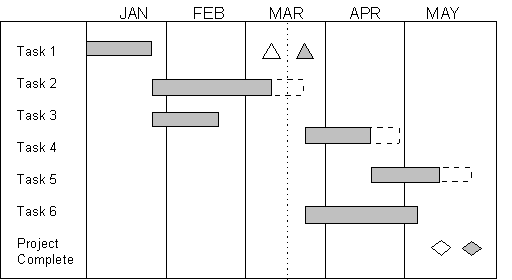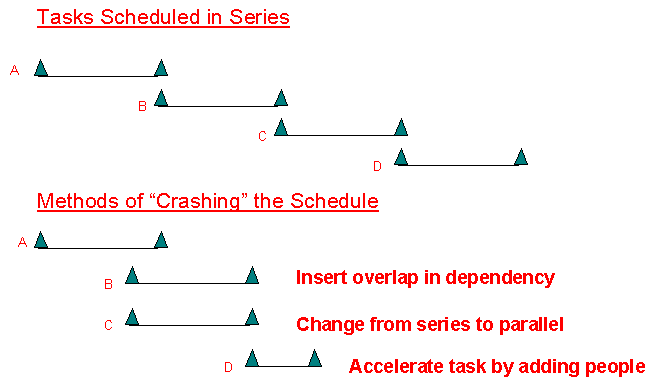
Project Schedule Estimating
Scheduling is an inexact process in that it tries to predict the future. While it is not possible to know with certainty how long a project will take, there are techniques that can increase your likelihood of being close. If you are close in your planning and estimating, you can manage the project to achieve the schedule by accelerating some efforts or modifying approaches to meet required deadlines.
One key ingredient in the scheduling process is experience in the project area; another is experience with scheduling in general. In every industry area there will be a body of knowledge that associates the accomplishment of known work efforts with a time duration. In some industries, there are books recording industry standards for use by cost and schedule estimators. Interviewing those who have had experience with similar projects is the best way to determine how long things will really take.
When preparing a schedule estimate, consider that transition between activities often takes time. Organizations or resources outside your direct control may not share your sense of schedule urgency, and their work may take longer to complete. Beware of all external dependency relationships. Uncertain resources of talent, equipment, or data will likely result in extending the project schedule.
Experience teaches that things usually take longer than we think they will, and that giving away schedule margin in the planning phase is a sure way to ensure a highly stressed project effort. People tend to be optimistic in estimating schedules and, on average, estimate only 80% of the time actually required.
Failure to meet schedule goals is most often due to unrealistic deadlines, passive project execution, unforeseen problems, or things overlooked in the plan.
The Gantt Chart

Taking its name from early project management innovator Henry L. Gantt, the basic Gantt chart is an easy way to document schedules. It is a horizontal-bar schedule showing activity start, duration, and completion. It shows the connection between events and the calendar, and provides a graphical analog of the activity duration.
The Gantt schedule can illustrate the relationship between work activities having duration, events without duration that indicate a significant completion, and milestones that represent major achievements or decision points. Various annotations can be used to communicate the progress of the project effort compared to the baseline plan, as well to depict in a graphical way areas where there are modified expectations from the baseline plan.
Once a Gantt schedule has been established for a project, progress should be periodically plotted against the baseline schedule. If different functional areas are involved in a project, each area may need its own detailed schedules to support the project master schedule. In such cases it is important that working schedules be linked to a common master schedule in a way that they can be easily updated. Each activity or event on the schedule should have a responsible individual assigned, so there is clear ownership and so schedule status can be updated without a lot of fuss.
Resource Leveling:
Projects will often be confronted by time and organizational constraints that limit their ability to obtain human resources. Sometimes staff can be supplemented through temporary help from technical service agencies. When staffing requirements are identified and constraints are understood, work plans can sometimes be adjusted to fit requirements to available resources.
Resource scheduling is one of the greatest challenges for projects without access to large organizational or job-market resource pools. Project planning should address such issues as redundancy of critical resources, resource capacity, bench strength in vital areas, and contingency plans to handle departures of key personnel.
Most of the popular project management software packages enable the project resource planner to assign staff to project tasks, display resource requirements profiles, and adjust the schedule of slack tasks so resource requirements more closely fit those available in the organization. Some packages can display multiple project resource requirements to facilitate organization-wide resource management, optimization, and leveling. Individual project requirements may be adjusted by manipulating schedule slack in tasks not on the critical path. This can facilitate allocation and leveling of staff throughout the organization.
Unless one person is working on each task full time, the schedule duration on the Gantt chart will not be the same as the effort required. Effort requirements will drive project cost, but durations will drive the schedule. These distinctions are helpful when reconciling project and resource schedules.
"Crashing" the Schedule:
Efforts to accelerate a project schedule are commonly grouped under the term "crashing" the schedule. Maybe this term was coined to suggest that there is always some price for driving a project to completion sooner than normal. There are a number of ways to improve the schedule when your boss says, I need it sooner!
1. Add people to the schedule. Additional staff must be added early in a project or they will slow it down while learning the ropes. If you add people, you may also need to add staff for supervision and coordination, so staff are fully applied.
2. Improve productivity and work longer hours. A good team atmosphere with management support can help make this happen. Without positive nourishment of this process, you could lose your team to attrition.
3. Review schedule dependencies and look for opportunities to overlap tasks or make serial tasks concurrent or parallel activities. This requires greater coordination and sometimes involves increased risks which need to be managed carefully.
4. Review the project scope and remove or delay features or functionality from the project critical path.
5. Consider innovative approaches such as a different development methodology, alternative technologies, or out-sourcing options.
